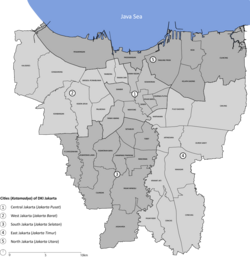
Wage Rudolf Soepratman was an Indonesian journalist and songwriter who wrote both the lyrics and melody of the national anthem of Indonesia – "Indonesia Raya". He is an Indonesian National Hero.
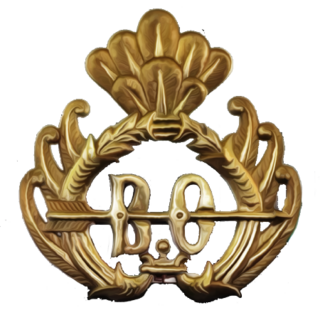
Budi Utomo was an early native nationalist political society in the Dutch East Indies. The organization's founding in 1908 is considered instrumental to the beginning of the Indonesian National Awakening.
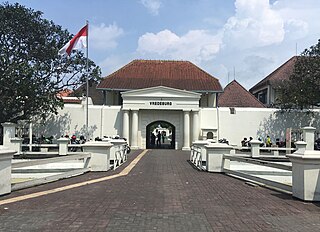
Fort Vredeburg Museum was a former colonial fortress located in the city of Yogyakarta, Special Region of Yogyakarta, Indonesia. The military complex has been converted into a museum of the Indonesian independence struggle which was opened in 1992. It is located in front of Gedung Agung and near the Kraton Yogyakarta.

The Indonesian National Awakening is a term for the period in the first half of the 20th century, during which people from many parts of the archipelago of Indonesia first began to develop a national consciousness as "Indonesians".

The National Museum of Indonesia is an archeological, historical, ethnological, and geographical museum located in Jalan Medan Merdeka Barat, Central Jakarta, right on the west side of Merdeka Square. Popularly known as the Elephant Museum after the elephant statue in its forecourt, its broad collections cover all of Indonesia's territory and almost all of its history. The museum has endeavoured to preserve Indonesia's heritage for two centuries.
The Ulema National Awakening Party was an Islamist political party in Indonesia. The party's main voter base was members of traditionalist Muslim organisation Nahdlatul Ulama. PKNU was established by Indonesian ulemas seeking a new political vehicle to promote Islamic political values outside the National Awakening Party.
Paguyuban Pasundan is a Sundanese cultural organization that was founded on 20 July 1913, and is one of the oldest organizations in Indonesia that still operates. During its existence, the organization has been moving in the field of education, socio-cultural, politics, economy, youth and women empowerment. Paguyuban Pasundan works to preserve the Sundanese culture.

The Jakarta History Museum, also known as Fatahillah Museum or Batavia Museum, is located in the Old Town of Jakarta, Indonesia. The building was built in 1710 as the Stadhuis of Batavia. Jakarta History Museum opened in 1974 and displays objects from the prehistory period of the city region, the founding of Jayakarta in 1527, and the Dutch colonization period from the 16th century until Indonesia's Independence in 1945.

Frans Hendrik Karel Zaalberg was an Indo (Eurasian) journalist and politician in the Dutch East Indies.

The National Library of Indonesia is the legal deposit library of Indonesia. It is located at Gambir, on the south side of Merdeka Square, Jakarta. It serves primarily as a humanities library alongside several others holding national responsibilities for science and agriculture. The national library was established in 1980 through a decree of the Ministry of Education and Culture and the consolidation of four different libraries. It maintains the status of a non-departmental government institution and is responsible to the President of Indonesia.

Colonial buildings and structures in Jakarta include those that were constructed during the Dutch colonial period of Indonesia. The period succeeded the earlier period when Jakarta, governed by the Sultanate of Banten, were completely eradicated and replaced with a walled city of Batavia. The dominant styles of the colonial period can be divided into three periods: the Dutch Golden Age, the transitional style period, and Dutch modernism. Dutch colonial architecture in Jakarta is apparent in buildings such as houses or villas, churches, civic buildings, and offices, mostly concentrated in the administrative city of Central Jakarta and West Jakarta.

The Volksraad was an advisory, and later semi-legislative institution for the Dutch East Indies, provided for by law in 1916 but only established with the actual installation of the Council in 1918. It was a hesitant and slow attempt at democratisation of the Dutch East Indies as part of the "ethical policy" adopted by the Dutch government. The power of the Volksraad was limited as it only had advisory powers. Although part of the council was elected, only a small proportion of the population had voting rights.

The Jakarta Art Building, historically known as Schouwburg Weltevreden, is a concert hall in Sawah Besar, Central Jakarta, Indonesia, built during the colonial period in Batavia, Dutch East Indies.

Mohammad Husni Thamrin was a Eurasian-Betawi political thinker and Indonesian nationalist who advocated for the independence of the Dutch colony in the East Indies. After his death he was regarded as an Indonesian National Hero.

Cultural properties of Indonesia are those items defined by Indonesian law as of "important value for history, science, and culture", and include both man-made artefacts and natural objects. The cultural properties number more than 8,000 and include ancient Hindu and Buddhist temples, mosques, historic colonial buildings, forts, art galleries, national parks and beaches. A number of the sites are World Heritage Sites.
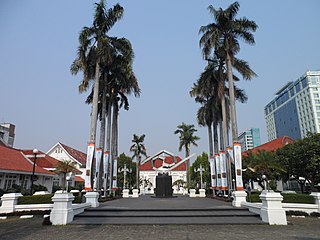
The National Gallery of Indonesia is an art gallery and museum in Jakarta, Indonesia. The National Gallery of Indonesia has existed as a cultural institution in the field of visual arts since May 8, 1999. The institution plays an important role in expanding public's awareness of artworks through preservation, development and exploitation of the visual arts in Indonesia.
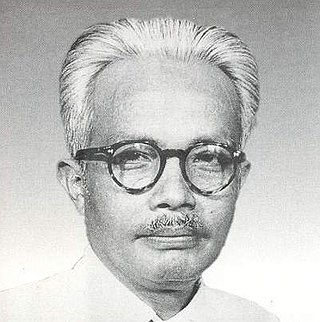
Ki Sarmidi Mangunsarkoro acted as the Minister of Education and Culture of Indonesia in 1949 until 1950. He is now regarded as a National Hero of Indonesia.

Dharma Wiratama Museum, officially the Dharma Wiratama Central Army Museum is a military museum centred on the history of the Indonesian Army from its inception in 1945 up through the coup of 30 September 1965 and Indonesian peacekeeping missions. It is located in the former national army headquarters in Yogyakarta.

The National Press Monument is a monument and museum to the national Indonesian press. Formally established in 1978, more than 20 years after it was first proposed, the monument is located in Surakarta, Central Java, and operated by the Ministry of Communications and Informatics. The complex consists of an old society building, which was constructed in 1918 and used for the first meeting of the Indonesian Journalists Association, as well as several subsequent expansions; it is listed as a cultural property of Indonesia.

